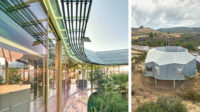Superpowers of 10, a play by architect Andrés Jaque and his Madrid-based Office for Political Innovation, starts innocuously enough—the stage-ready version of the iconic Eames’ 1977 short film Powers of 10, performed during the opening weekend of the Chicago Architecture Biennial, reenacts an idyllic picnic on Lake Shore Drive and a journey through space and subatomic particles, using the adorable medium of papier-mâché props on wheels.
The plot, however, doesn’t stay so cute. Broaching what Jaque calls “unspeakable” topics in architecture, Superpowers continues where the Eames’ nine-minute short ends by mining its footage for underlying political and social “complexities”: The film’s narrator Phillip Morrison, for example, went on to advance the development of nuclear weapons. (According to the play’s narration, he loaded the plutonium bomb onto the plane to Hiroshima himself.) The grass the two protagonists are lying on is conflated with Monsanto’s sinister, environmentally-debilitating corporate interests. Even the Kodak film that the Eames helped to popularize played a hand in South African apartheid, as well as an exclusionary “global chromatic preference” for white people.
Jaque’s goal was to make these unspeakable topics speakable in the realm of architectural discourse. “By speakable, I mean something that architects consider part of the scope of their practice,” he explained. “Everyone talks about sustainability now, for example, but it hasn’t always been that way. At some point, someone made the effort to introduce that into architectural conversations.”
The play itself is testament to the rapid evolution of popular discourse. Although it was written in 2013 as a commission by Beatrice Gallilee and Jose Esparza for the Lisbon Triennale, it struck uncanny cords with current events: a scene recalling the demolition of the Austrian-Hungarian border resonates loudly with Europe’s refugee crisis; another scene advocating transgender equality aligns with the recent media hysteria over Caitlyn Jenner.
Besides a higher-budget sound system and staging indoors at the Chicago Athletic Association hotel rather than a public square (thanks to CAB’s generous funding by BP), nothing about the performance changed between Lisbon and Chicago. Its enduring synchronicity with newspaper headlines speaks to the universality of its issues—ones that might one day prove themselves worthy to architects for discussion.





